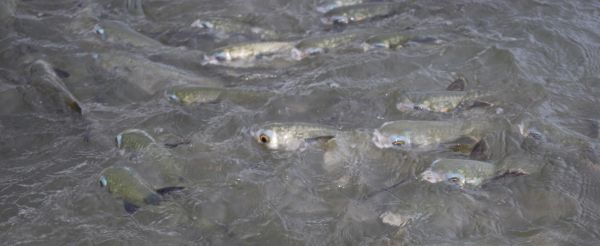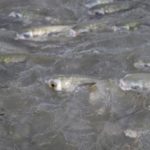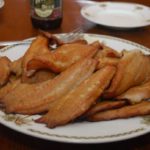
The striped mullet is a fish of many names. By one count, it carries 21 English names and at least 144 in other languages. It is “jompo” in Malagasy, an appropriate-sounding name for this most airborne of fish. In Dutch it goes by “diklipharder.” You figure that one out.
In Louisiana, they are most often just called “mullets.” If the speaker feels the need to separate them from the two species of kingfish (which are really members of the drum family) that we curiously call “channel mullets” or “ground mullets,” he may refer to them is “popeye mullets.”
The name may not be flattering, but it is descriptive. They have huge eyes.
Scientists cut through all the name clutter by calling them Mugil cephalus. “Mugil” means “mullet” in Latin, which in turn may be derived from “mulgeo,” which means “to suck.” Those who have seen mullets sucking in scum from the water’s surface know that the name is descriptive.
So is the specific name, “cephalus,” which simply means “head.” Their heads are indeed boney and hard, as many a nighttime boat operator has found out after being beaned by one.
One of the reasons for the many foreign names for the fish is that it is truly found worldwide in all coastal waters except those of the polar or near-arctic regions. In most places, it is a valued food fish. In the Gulf of Mexico, mullet are prized from Mississippi to Florida, although Louisiana isn’t left completely out of the mullet-eating picture. In Grand Isle, they were so popular that restaurants sold them as “Grand Isle Ham” until very recently.
Mullet have to be caught to be eaten, and therein lies the rub. Mullet are sometimes taken in fresh water by hook (using earthworms and. believe it or not. oatmeal or chicken-laying mash), but by and large their diet makes them difficult to capture with hook-and-line. Unfortunately, freshwater mullet have an objectionable musty taste, probably related to their diet.
Most saltwater mullets are captured with nets — strike nets (actively tended gill nets) by commercial fishermen or by sports fishermen using cast nets. Commercial strike net seasons in Louisiana are confined to the fall, when the fish mass up for their annual spawning migrations.
Most of the value of the commercial fishery is in the roe of the fish. Male fish produce “white roe,” essentially their sperm-filled testes which are sold in the Middle East. The more-valuable female fish produce yellow roe, egg sacks that are salted, dried and compressed before being sold in Asia.
Some of the Gulf Coast commercial catch and almost all of the recreational catch is for the fish’s flesh itself.
Fried mullet is most popular, although the rich, fatty flesh lends itself especially well to smoking. The high oil content of the flesh that gives it its rich taste makes the fish difficult to freeze well and even limits how long it can be held fresh. They are best eaten sooner rather than later.
Striped mullet are not only found all over the world, but all over the marine and estuarine ecosystems where they occur, from pure fresh water to full-strength sea water.
The typical striped mullet starts life being spawned between October and February, most likely in December or January, 40 to 50 miles offshore in waters up to 1,000 feet deep off the edge of the continental shelf. Females will each produce as many as 2 million eggs.
Each fertilized egg contains an oil globule making it buoyant. After hatching, the larval mullet will remain in high-salinity offshore waters until they grow to juveniles measuring .6 to .8 inches long. At this size, they either swim or are carried by currents into inshore waters and estuaries where they complete their growth.
The larger the mullet becomes the more tolerant it is to low salinity. Adult mullets have been found hundreds of miles up freshwater rivers.
Males mature at age 2 and 10 inches in size. Females may spawn at 3 years old and 12 to 16 inches long.
No matter where they are found, in fresh water or salt, mature fish begin to feel the tug of nature and mass up during the fall in high-salinity lower estuaries before making their impressive high-speed spawning run.
The huge schools they form allow them to swim more efficiently during the migration, but the efficiency comes at a price.
Studies have shown that water on the back edge of a large school of mullets has 29 percent less oxygen than water at the front of the school. Perhaps this is the reason for migrating schools constantly breaking up and reforming and changing the position of fish within the school.
Out-migrating fish are sleek, fat and swollen with eggs. Mullet returning to estuaries after the spawn have less fat reserves, broken and worn fins, and sores on their bodies. Spawning is a tough job.
The diet of mullets places them in a valuable position in the food chain. Mullet feed by siphoning up bottom mud, sand and detritus (the remains of once-living things) and algae. They will also graze algae off logs and submerged plants, and are often seen sucking in the algae-rich scum on the water’s surface. These foods are ground in a muscular extension of the stomach called a gizzard. (Gizzards are often fried and eaten by human epicures.)
Mullets are important to the ecosystem. Few fish their size convert plants into animal protein available for larger predator species. Inshore mullet are gobbled by speckled trout and redfish. During their offshore spawning run, green-water and blue-water predators, from jacks to tunas and billfish, gorge themselves on their fat-rich bodies.
Probably nothing about mullets arouses more interest among biologists than trying to figure out why they jump so often. Unlikely explanations are that they do so to get rid of parasites, clear their gills to get more oxygen or simply to play.
A believable explanation involves their huge, well-developed eyes. They jump to avoid danger, whether the predator be another fish or a human. A net set in clear water during daylight hours, even a monofilament one, produces an impressive mullet-jumping display.




